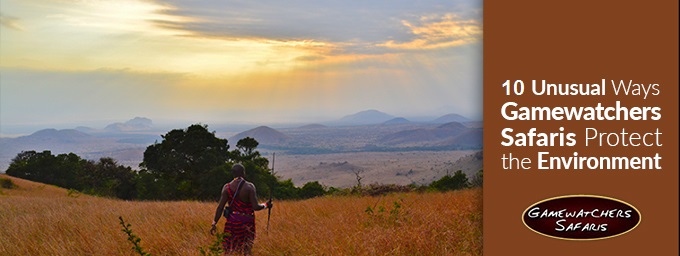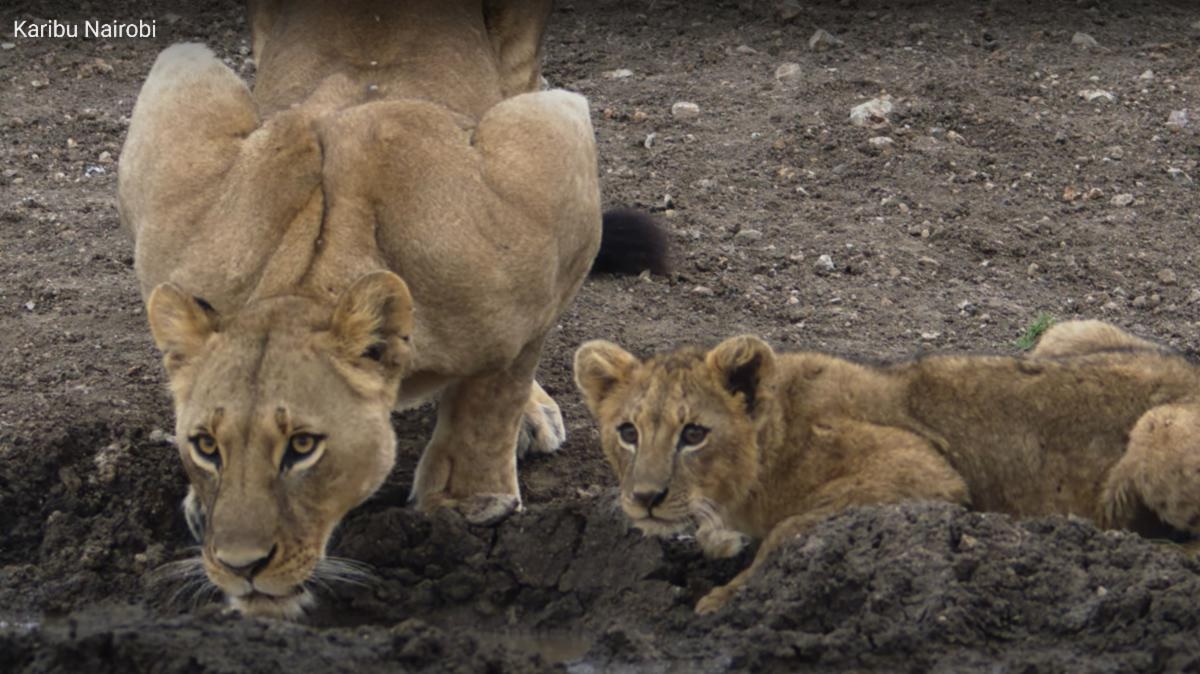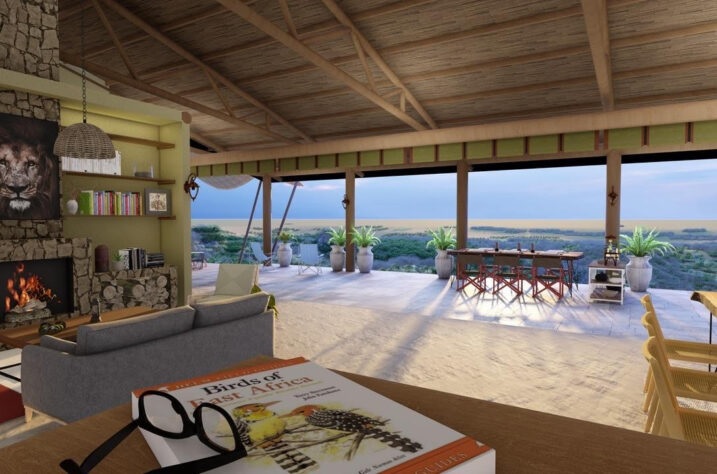
A night drive in Selenkay Conservancy and a visit into the National Park – Clinton Richardson muses on his Amboseli experience …
* * * * * * * * * * * * * * * * * * * * * * * *
This series of blogs will take you on Clinton’s safari in Kenya as he travels from Atlanta (USA) to Nairobi National Park, Selenkay Conservancy (Amboseli), Ol Pejeta Conservancy (Laikipia) and Olare Motorogi Conservancy (Maasai Mara). Let’s join him on his journey as he shares his insights into the conservancies, Porini Camps and the people (and animals!) that he meets along the way. All images are from Clinton’s TrekPic.com photo site. Blog entries are from his Venture Moola blog at ReadJanus.com.
* * * * * * * * * * * * * * * * * * * * * * * *
As our 8:00 p.m. dinner is winding down on our first day at the Amboseli camp the staff announces that lion have been spotted approaching the nearby watering hole. An impromptu night drive is arranged and we gather cameras and hop into our vehicles to observe four lions (two pictured above) as they make their way to a nearby waterhole. A few elephants are already there and none are too eager to relinquish their spot.
Our vehicles are equipped with large red lights which are shined into the grass to reveal the lions. And while it is fun to be out in the night air, the cats seem bothered by the lights and so I am ready to head back after a short drive.
The next morning we are up early for breakfast and a full day game drive. The ultimate destination is Amboseli National Park, a 90 minute drive on dirt roads through the Selenkay Conservancy. Along the way we stop and head off road to follow lion tracks seen on the road. Remarkably, our driver sees these prints while driving 30 miles an hour.
The lions elude us but we do catch a glimpse of the odd fellow above. He is a called a gerenuke. The long neck enables him to feed on trees and bushes at levels above where his gazelle cousins graze and below the tops that are so popular with giraffes.
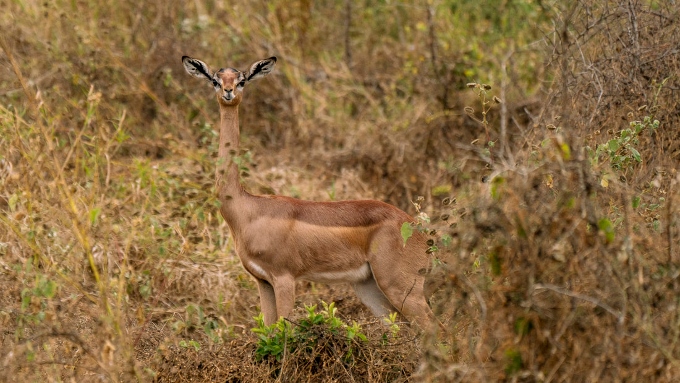
The Gerenuke
As we drive on toward Amboseli the terrain changes from bushy and tree filled, too more open but with frequent brush and trees and then, at parks edge, to a wide open grass plain with occasional acacia trees in the distance. The grasses are high, maybe 3 feet or more, and they are everywhere. There has been lots of rain this year.
We have been driving for quite awhile, so our driver pulls us into a parking lot for a small airstrip within the park. We are the only ones there. A table is set out with refreshments and as we talk our eyes are drawn to a female ostrich. A male ostrich in the distance is heading her way. After they meet, short dance follows that seems not to impress the female.
The disappointed male heads off until he spots another male heading his way. We watch with anticipation.
When the two males meet they quickly begin interacting. A fight ensues that seems as much dance as fight but with plenty of contact. After about five minutes, the challenger prevails and heads off to try his luck with the reluctant female. We pack up to head further into the park.

Fighting for the Girl
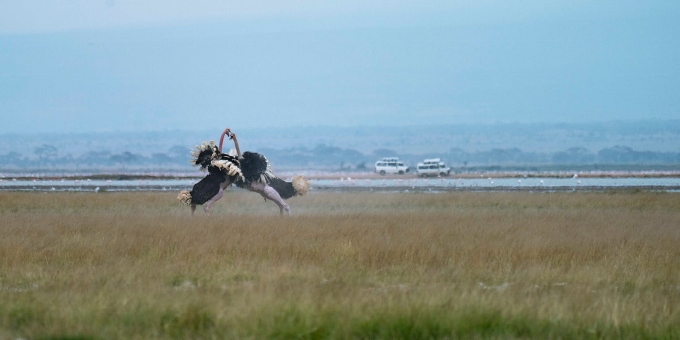
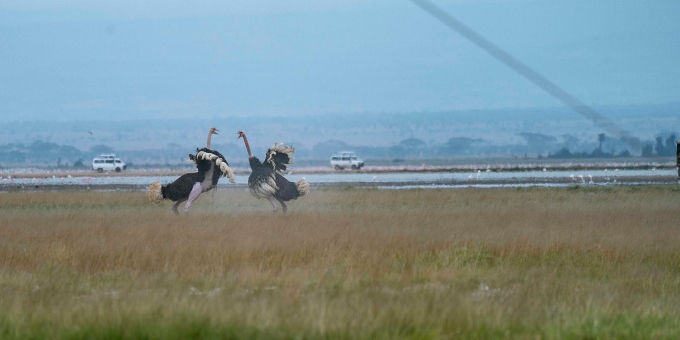
We proceed from the airstrip in our vehicle over more grassland to an area of marshes. The wildlife gets more and more abundant as we get close. Zebra, wildebeest, impala, elephant, secretary birds and more fill the marsh and its edges.
Along the far horizon, are families of elephants marching toward the marsh in single file. Between the horizon and the marsh are many more families making their way to the marsh.

Elephants in the Distance
The marsh itself is filled with life. Zebra, wildebeest, gazelles, warthogs, birds, elephants and rhinos are all either in the marsh or at its edges.
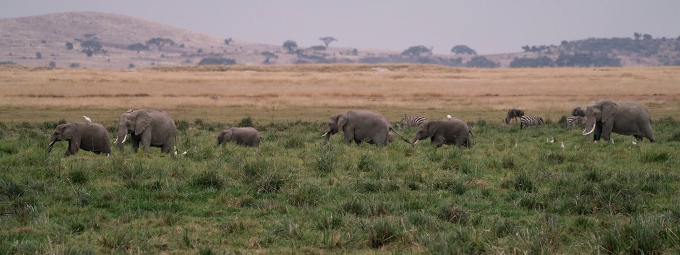
At the Edge of the Marsh
Elephants are everywhere. On the hill heading to the marsh, at the edges of the marsh, in the marsh and even partially submerged in the marsh. This must be what heaven looks like to an elephant.

Heaven for Elephants
I do not think I am doing the experience justice. Hopefully the pictures help.
The temperatures are mild, the skies are open, and there are only a few safari vehicles on the road. In front of us is the marsh full of animals co-mingled by species and busy grazing or walking. We sit and just watch as family after family of elephants make their way down to and into the marsh and as zebra, hippo, wildebeest and gazelles graze. There are hippo too, in the marsh and grazing on its grasses.
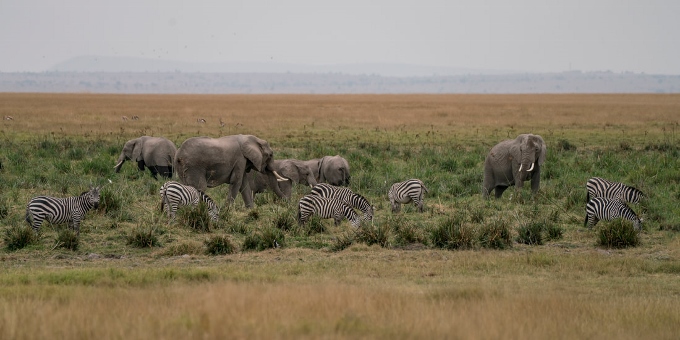
Safari Salad
Eventually tummies begin to rumble, ours not theirs, and we make our way up to a picnic site on top of a nearby hill. From there we can see miles of grassland and the large marsh that fuels the parade of life we are witnessing.
We are not alone. School buses unload groups of uniformed school children on holiday and other tourists fill the hilltop with us. It has been a full morning.

Hippos below our lunch spot
First published 25 Oct 2018. All photos and text are © Clinton Richardson. All images are from his galleries at TrekPic.com
About Clinton Richardson
Clinton Richardson has been writing and taking photographs for decades. His books include the critically acclaimed 5th edition Richardson’s Growth Company Guide 5.0 and the award-winning book about social media and ancient coins called Ancient Selfies. His images, including images taken on his trip, can be viewed at TrekPic.com. His Venture Moola blog can be viewed at Readjanus.com.
See Other Blogs in this Series:
- Safari Countdown: Prepping for Kenya
- Safari 1: The Hunt
- Safari 2: Off to Nairobi
- Safari 3: Tented Camps & Conservancies
- Safari 4: Passports in His Underpants
- Safari 6: Amboseli to Selenkay
- Safari 7: Pooh On You
- Safari 8: Eaten by a Lion?
- Safari 9: The Maasai
- Safari 10: On the Move
- Safari 11: Crash on the Grass
- Safari 12: Sundowner Surprise
- Safari 13: Stalag Panzee
- Safari 14: Bump in the Night
- Safari 15: Dry Season Showers
- Safari 16: How Many Wives Would You Like to Have?
- Safari 17: Distracting His Highness
- Safari 18: How to Eat a Tree
- Safari 19: Hunting with Children (well, cubs!)
- Safari 20: Blue Jean Symphony
- Safari 21: African Nights
on Monday 12th November 2018 at 09:20



